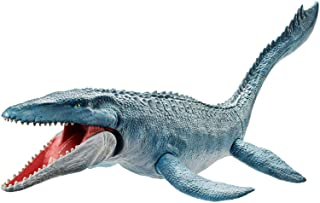卵の化石―君は誰?
2011年に南極で見つかり、チリの博物館に展示されていたフットボール大の謎の化石について、これまで発見された中で最大の軟殻卵であることを明らかにしたとする最新の分析結果が17日、発表されたのです。
さあ、定説を覆す新事実とは。。。さあ~ロマン!!
- 南極の'フットボール' 化石は世界で2番目に大きい卵
- 結局モササウルス属の可能性?!
- エピオルニス(Elepahnt Bird) 世界最大の鳥
- それ以外にも発見されている「柔らかい殻をもつ卵」の化石
- 「The Thing」の由来
- 原文 Antarctica’s ‘Football’ Fossil Is World’s Second-Biggest Egg
南極の'フットボール' 化石は世界で2番目に大きい卵
Antarctica’s ‘Football’ Fossil Is World’s Second-Biggest Egg
科学者たちは最近、珍しい発見を報告しました:現存することが知られている2番目に大きい卵の発見です。その卵は6,800万年前の化石で、南極沖のシーモア島で発見されました。
化石の大きさはー空気の抜けたーサッカーボールくらいと言われています。大きさは約29センチ×20センチ。それは、以前に死んだマダガスカルの大きなエピオルニス(Elepahnt Bird)の卵よりも少しだけ小さい、と科学者たちは言います。
鳥類や多くの恐竜が硬い殻の卵を産み出していたのに対し、南極の卵は柔らかい殻を持っていたのです。
「この新しい卵は、南極で発見された最初の化石卵であり、これまでに発見された中で最大の柔らかい殻の卵なのです。」とルーカス・レジェンドレ氏は述べています。彼はテキサス大学オースティン校の古生物学者であり、雑誌「ネイチャー」に掲載された報告書の筆頭執筆者です。
レジェンドレ氏は、卵を空気を失ったサッカーボールに例えました。「片側が平らになっており、そこが海底に接触した場所であることを示唆しています。卵の殻は非常に薄く、トカゲやヘビの卵のようにミネラル分が乏しいのです。」と彼は言います。
卵が作られた当時、南極で卵を産むのに十分な大きさの生物は、海を泳ぐ爬虫類だけでした。この化石の発見は、研究者たちに、これらの動物が生きている子供を産んだだけではないかという考えに疑問を抱かせています。
母親の骨が発見されなかったのです、ですから科学者たちは、どの動物が産んだのかを言うことができなかったのです。産み落とした可能性が高いのは、モササウルスとプレシオサウルスです。前者は15メートルの長さに達することができ、一方後者は10メートルの長さに達することができた、とレジェンドレ氏は言います。
モササウルスとプレシオサウルスは恐竜と同じ時期に絶滅しました。彼らは、報告によると 小さく、岩のような物体である小惑星が6600万年前に地球を襲った後に消えました。
チリ大学とチリの自然史博物館からの科学者は、2011年に珍しい化石を発見したのですが、それが何であるかわからず、彼らは "The Thing"「物体」と呼んでいまいた、 SF映画の名前にちなんで。
「キャンプに到着したとき、私たちに同行した地質学者に尋ねました、 今までにこのような物を見たことがあるかどうかと。」「彼らの困惑した表情が全てを物語っていましたね。」と、チリ古生物学の研究者ロドリゴ・オテロ氏は語ってくれました。
結局モササウルス属の可能性?!

この卵は恐竜ではなく、爬虫類の一種モササウルス属のものかもしれないと、研究チームは考えている様です。肉食海生爬虫類モササウルスは当時、この地域に広く分布していとのこと。 この卵が発見された場所では、モササウルスの子どもや首長竜プレシオサウルスと呼ばれる他の海生爬虫類などの骨が見つかっていることも、研究チームの説を補強しているそうです。【翻訳編集】 AFPBB News
 出典;Amazon
出典;Amazon
サイズ体高2.9m/体長16.7m体重28t食性肉食
先史時代、海の食物連鎖の頂点に君臨したモササウルスは、あらゆる海洋生物を捕食します。大きく開く二重関節のあごで、プレシオサウルスやホオジロザメなどの獲物を丸呑みします。モササウルスは、実は恐竜ではなく海生爬虫類なのです。
エピオルニス(Elepahnt Bird) 世界最大の鳥
「世界最大の鳥」めぐる論争、ついに決着 写真1枚 国際ニュース:AFPBB News

巨大な飛べない鳥エピオルニス(象鳥)の想像図(2018年9月25日提供)。(c)AFP PHOTO / Zoological Society of London / Jaime CHIRINOS
ダチョウに似た飛べない鳥で、背の高さは最大3.35メートル。その巨大な卵は、平均的な鶏卵の100倍に達するという。
ニュージーランドの絶滅した鳥モアとの近縁種である象鳥は、現在のキウイやエミュー、ダチョウなどの走鳥類と同じ科に属している。
それ以外にも発見されている「柔らかい殻をもつ卵」の化石
「The Thing」の由来
SF映画ジョン・カーペンター監督『遊星からの物体X』で南極大陸で発見された謎の物体にちなんで「The Thing(物体)」だそうです。
ジャパン
あらすじ:
物語の舞台は冬の南極基地。ノルウェーの南極観測隊が、氷の中に閉じ込められた未知の生命体を発見。古代の生物ではないかと推測され、その調査のために考古生物学者ケイト(メアリー・エリザベス・ウィンステッド)が彼らの基地に向かう。だが、生命体は解凍されて長い眠りから覚醒。しかも、それはほかの生物の体内に侵入しては、細胞を同化して宿主そのものに擬態する、宇宙からやって来た生命体だったのだ。人間の体内に侵略し擬態をする“物体X”は、南極隊の仲間へと次々に姿を変え孤立した基地内に潜む。やがて疑心暗鬼に陥った隊員たちは死と隣り合わせの混乱の一夜を迎える―。Yahoo映画より
人間の空想、創造ってすごいですね。それこそが果てしない広がりでね。
原文 Antarctica’s ‘Football’ Fossil Is World’s Second-Biggest Egg
 General view of a fossil egg of a marine reptile, found in Antarctica, in this picture obtained by Reuters on June 16, 2020. (UNIVERSITY OF CHILE/Handout via REUTERS
General view of a fossil egg of a marine reptile, found in Antarctica, in this picture obtained by Reuters on June 16, 2020. (UNIVERSITY OF CHILE/Handout via REUTERS
Scientists recently reported an unusual finding: the discovery of the second-largest egg known to exist. The egg, a 68 million-year-old fossil, was found on Seymour Island, off the coast of Antarctica.
The fossil is said to be about the size of a football – without the air inside. It measures around 29 centimeters by 20 centimeters. It is only a little smaller than the eggs of the large elephant birds of Madagascar, which died off some time ago, scientists said.
While birds and many dinosaurs produced hard-shelled eggs, the Antarctic egg has a soft shell.
“This new egg is the very first fossil egg from Antarctica, and the largest soft-shelled egg ever discovered,” said Lucas Legendre. He is a paleontologist at the University of Texas at Austin. He was the lead writer of the report published in the journal Nature.
Legendre compared the egg to a football that had lost its air. “One side is flattened, suggesting that is where it came in contact with the sea floor. Its eggshell is very thin, and poorly mineralized, like in the eggs of lizards and snakes,” he said.
At the time the egg was made, the only creatures in Antarctica that were large enough to lay it were seagoing reptiles. The discovery of the fossil makes researchers question the idea that these animals only gave birth to live young.
The bones of the mother were not found, so scientists were not able to say which animal laid it. Among the likely creatures to have laid it are species of mosasaurs and plesiosaurs. The former could reach lengths of 15 meters, while the latter could reach lengths of 10 meters, Legendre said.
Mosasaurs and plesiosaurs died off at the same time as the dinosaurs. They disappeared after an asteroid, a small, rocky object, reportedly struck Earth some 66 million years ago.
Scientists from the University of Chile and Chile’s Museum of Natural History found the unusual fossil in 2011. Unsure about what it was, they called it “The Thing,” after the name of a science-fiction film.
“When we arrived at camp, we asked the geologists that accompanied us if they had ever seen anything like it,” said University of Chile paleontology researcher Rodrigo Otero. “Their expression of bewilderment said it all.”
_____________________________________________________________
Words in This Story
fossil – n. something (such as a plant leaf, skeleton, or footprint) that is from an animal or organism which lived in ancient times
dinosaur – n. one of many creatures that lived on Earth millions of years ago
paleontologist – n. a scientist that deals with the fossils of animals and plants that lived very long ago especially in the time of dinosaurs
journal – n. a magazine or other publication that specializes on a subject or activity
lay – v. to produce an egg from inside the body
reptile – n. a group of animals that includes snakes, crocodiles and turtles
species – n. a group of living organisms made up of similar individuals
geologist – n. a scientist who studies rocks and/or soil to learn about the history of the Earth and its life
bewilderment – n. the feeling of being unable to think clearly
 出典:
出典: